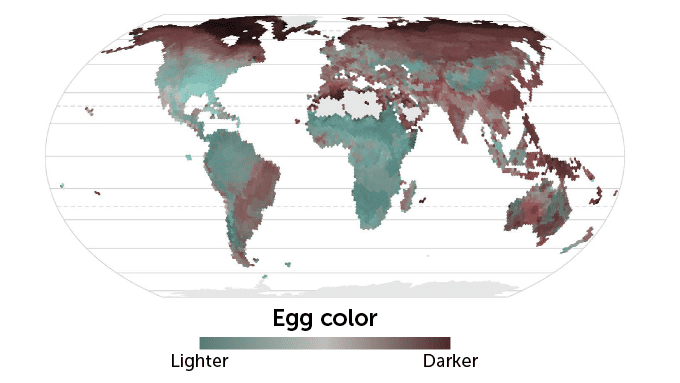
Bird eggs come in different shapes, sizes, and patterns. Biologists have long puzzled over why these differences happen in the first place, but the major drivers of variation have remained unclear. Of course, there are many different parameters at play: genetic differences, environmental adaptations, climate — but a new study reports a rather simpler rule that most eggs seem to obey. Simply put: the colder the climate, the darker the egg.
“The survival of a bird’s developing embryo depends on the egg’s ability to stay within strict thermal limits,” researchers write in the new study. “Birds living in cold habitats, particularly those with nests exposed to incident solar radiation, have darker eggs. We show evidence that darker eggs heat more rapidly than lighter ones when exposed to solar radiation.”
This makes a lot of sense. Darker pigments reflect less of the sunlight, which means they attract more heat. When cold weather is a problem, this can be lifesaving. But there’s more to this story.
Darker shells also filter out harmful ultraviolet radiation, which is stronger in warmer regions. Furthermore, dark pigments sometimes have anti-microbial properties — which means they often emerge in warmer, humid areas, where microbes and fungi are a significant threat. Meanwhile, lighter eggs tend to be seen more easily by predators in hot regions, which can also be a strong evolutionary driver. These factors explain why sometimes we see eggs that go ‘against the rules’ color-wise, such as being darker in the tropics or lighter in cold areas.

In order to reach these conclusions, Phillip Wisocki and colleagues from Long Island University Post in Brookville, New York, analyzed patterns of coloration and brightness from eggs belonging to 634 different species, belonging to 36 out of the 40 known orders of birds. They collected eggs both from natural environments and from museums, noting the egg coloration patterns and the geographical distribution of the birds.
They found that eggs are significantly darker when temperature and solar radiation are low. This was also the case when nests were built openly on the ground, rather than in cavities or nests — presumably as a way to camouflage the eggs.
The authors also exposed chicken, duck, and quail eggs of varying colors to solar radiation. This confirmed the theory: darker eggs were able to maintain their incubation temperatures for longer, suggesting that thermal regulation is a main driver of eggshell coloration.
Of course, it is not the only driver. Predation is also an important selection pressure on egg colors and patterns, researchers add. Since predators are generally adept at seeing lighter colors and predation is higher in hotter areas, this is a counterforce to the thermoregulation drivers — and helps to explain why sometimes, eggs are also darker in hotter environments.
The study “The global distribution of avian eggshell colours suggest a thermoregulatory benefit of darker pigmentation” was published in Nature Ecology.



